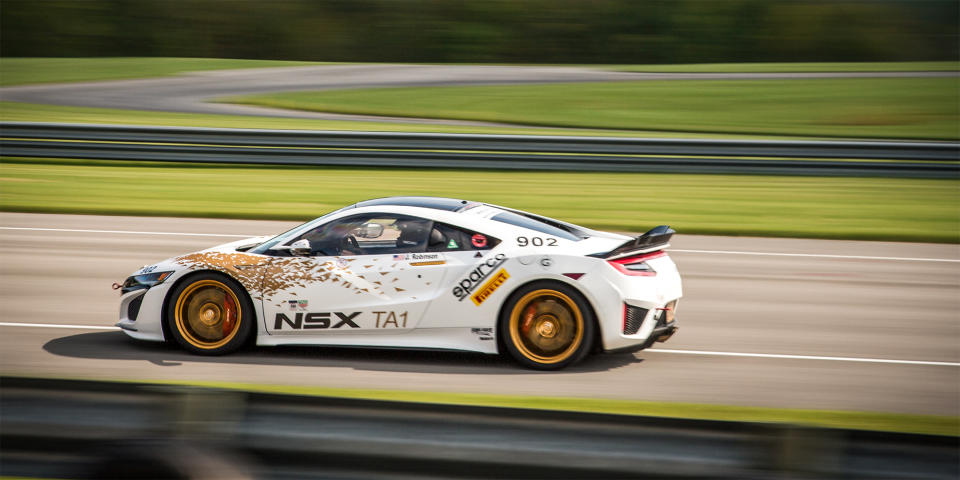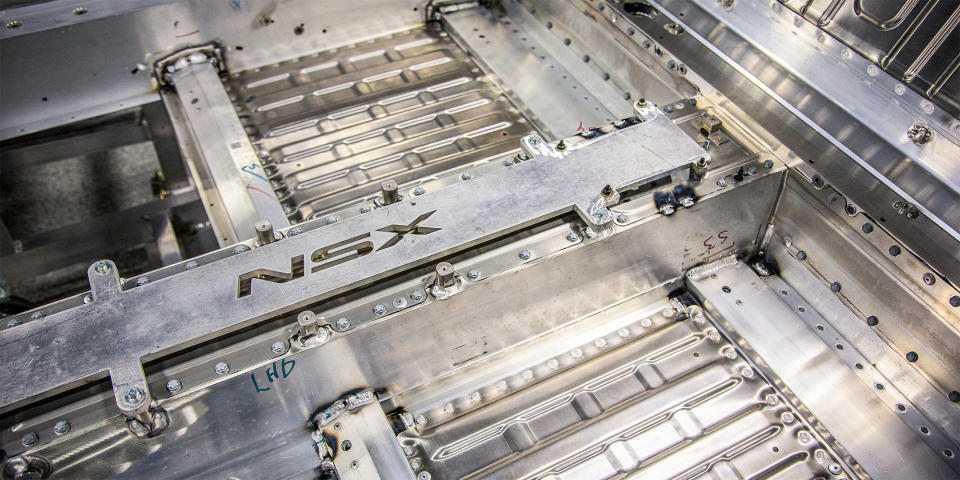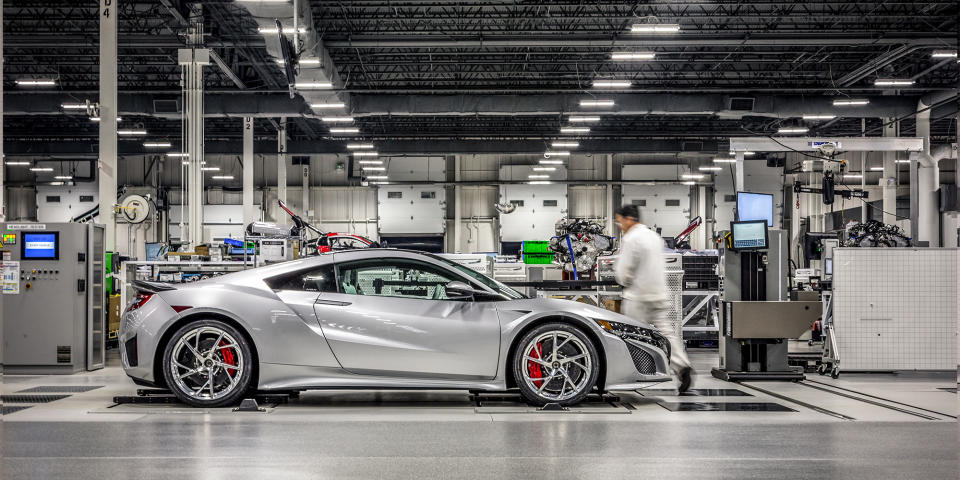The Unlikely Origin Story of the 2017 Acura NSX

MARYSVILLE, OHIO–We're watching a ballet of industrial engineering at Acura's Performance Manufacturing Center. Articulating-robot MIG welders dance along subassemblies. Workers in white lab coats carefully fasten parts to space frames starting each bolt by hand so as not to cross-thread the soft aluminum. Body panels, pegged to a rack like pieces of a life-size model kit, glide through a glass-walled paint booth. It all looks premeditated, perfect. But our tour guides, the leaders in developing the new Acura NSX, assure us with tired smiles that the path to the 2017 Road & Track Performance Car of the Year award did not always follow a tidy plan.
"At several points, the team's engineers asked me, 'Do you know whether it's going to work?'" recalls Clement D'Souza, who directed the manufacturing effort. "My answer was no."
Four years ago, Honda's then president, Takanobu Ito, revealed the NSX concept to much applause at the Detroit auto show and announced it would at long last be brought to market. He added that the supercar, the pride of Japan's most revered engineering firm, would be developed and built in the United States. There was a moment of stunned silence, then more clapping. People from Honda R&D, who'd made the short trip from Ohio, shared the elation but felt something else.
"Suddenly a thousand pounds were sitting on top of our shoulders," says NSX vehicle performance development leader Jason Widmer.

Making a supercar is a tall task for any engineering group but was a particularly big deal in Marysville. Above the low-walled cubicles in the R&D center hang the hoods of cars brought to life here: the MDX, the ZDX, and the last TL, among others. Nice-driving vehicles. Not Ferrari fighters.
Shortly after the auto show, the team-about 35 elite engineers nominated by various departments-gathered at Willow Springs raceway to sample their competitors, including an Audi R8, a Porsche 911 Carrera S, a Corvette Z06, and a Ferrari 458. "The trip of all trips," remembers Widmer. But the fun came with a terrifying realization: These cars were not just fast. They were good.
"I remember thinking-even though I didn't tell the guys who were working on the project-Oh my God, we're dealing with companies that have been doing this for years, and here we are, Honda, going to go after them," says Widmer.

The NSX would be jumping into shark-filled waters wearing what some considered to be dead weight: batteries and three electric motors. Top brass had snuffed out a proposal for a V10 powered NSX in 2008. The new sports-car experience had to be progressive. Porsche had not yet introduced the 918 Spyder. Would Acura really be able to deliver a similar car for a fifth of the price?
"The first stage was convincing our team that it was the right thing to do," says NSX global development leader Ted Klaus. "Even today we have pushback."
It was initially a very hard sell. Honda has been building hybrids since the late 1990s, but none of them were performance cars (sorry, CR-Z), let alone track cars that spent most of their time under full throttle and brake in short, hard spurts. When the team first ran a crude platform mule around Virginia International Raceway, they found it lapped eight seconds faster with its motors turned off.
And, of course, there was also the minor matter of making sure all this technology felt like a sports car. Nearly every aspect of the NSX-dampers, steering, powertrain, even the feel of the brake pedal-is governed by electronics and software.
"It was very clear from normal driving, street driving, that there was a huge benefit [to the motors]," says dynamic project leader Nick Robinson. "But then with the track-and this is not completely a track car-the question was, do the electric motors make it go faster?"
There were also questions about the gasoline engine. The initial plan was to borrow a naturally aspirated V6 from the RLX sedan and mount it transversely behind the driver. The ready-made powertrain was essential to getting the car to production within three years-another promise from the Detroit show. Within months of that announcement, though, many within the ranks were wondering if the powerplant would be sufficient.

"There was a big push in the beginning to get the product out quickly," remembers powertrain development leader Ken Lantz. "But then there was also a discussion. If we cobble together all these things that we have, is everyone going to accept it as an NSX?"
The car needed more power. Turbocharging would get it there but presented an even bigger problem: Turbos and their required cooling would never fit in the engine bay, where one of the exhaust manifolds already sat snug against the firewall. The solution, whispered at first but soon stated clearly at high-level meetings, was to turn the engine. In essence, throw the back of the car in the waste bin and start over. No easy decision. But Honda management still includes lots of engineers, none willing to compromise what was supposed to be an engineering showcase.
"One of the big benefits we had on this product, which slightly trumps our other products, is that nobody in the entire organization wanted this project to fail," says Widmer. "Everybody was thinking, it has to be great."

By the time a naturally aspirated prototype paraded around Mid-Ohio in the summer of 2013, with Widmer at the wheel, its transverse-engine layout was considered a dead-end within R&D.
The "heart transplant," as one team member described it, was not a simple matter. Car development, broadly speaking, happens in phases: engine, suspension, manufacturing. By scrapping the engine, the NSX team also had to scrap that regimen and go into crisis mode. Engineers in Marysville mocked up a new rear subframe even as their colleagues in Tochigi, Japan, frantically worked on the turbo engine and a new nine-speed transmission. The wind-tunnel model sprouted scoops and vents to cool the turbos. "Every single surface changed," says lead exterior designer Michelle Christensen. D'Souza, in manufacturing, was figuring out how to tighten tolerances in the space frame and suspension without knowing exactly what he was building.
And, of course, there was also the minor matter of making sure all this technology felt like a sports car. Nearly every aspect of the NSX-dampers, steering, powertrain, even the feel of the brake pedal-is governed by electronics and software. All of which was unfamiliar. All of which was being updated simultaneously in Japan and Ohio with unpredictable effects on the rest of the car.

"We had a pretty clear idea of what we wanted early on. Right from the beginning of the project, we were using words like 'linear and immediate response,'" says Robinson. "The work was ...how do you make the car do that?"
To borrow a phrase from Donald Rumsfeld, there were unknown unknowns. At one testing session, for instance, with none other than IndyCar champ Dario Franchitti at the wheel, the NSX oversteered wildly. Engineers discovered there had been a program update to the electric motors at the front wheels, which dramatically changed the car's handling.
All they could do was test and test some more. Long-distance caravans across the United States and Europe, regular sessions at the Nürburgring Nordschleife. About 20 trips in all, plus countless other road tests. "Coming together at various places around the globe, with all the key experts for each one of those knobs we were turning, was really critical," says Widmer.
Some discoveries were relatively small and could be changed on the spot or over conference calls with coders in Tochigi (translators are the unsung heroes of the NSX's development). Others, such as a lubrication issue that caused an early prototype to catch fire at the Ring, required deep teardowns. "I turned the corner, looked in the mirror, and saw flames," says senior vehicle dynamics engineer Dan Hassler, who was driving. "Not the highlight of our development," adds Klaus, who had been riding shotgun.

The process was costly and exhausting-Widmer, who has three kids, says many of his colleagues told him they'd want no part of his job. Slowly, though, the Rube Goldberg machine got faster. On the track, it finally is quicker with the hybrid system working, Robinson says. (Klaus hints there will be a version with less electrification and even higher performance.) More important, the NSX evolved into something these Ohio engineers and other car enthusiasts actually want to drive.
"I'm a purist. My father's a purist," says Klaus. "For us, the NSX is all about creating a new experience, something timeless." The original NSX, groundbreaking and impressive as it was, carried an air of inevitability. It was a fitting culmination of everything Honda and "Japan Inc." had accomplished in the 1980s. Nikon had figured out how to build the world's best cameras, Seiko the most reliable timepieces, Sony the finest electronics. Why wouldn't Honda knock Ferrari on its ass with a 270-hp, mid-engine sports car that was as easy to drive as a CRX?
This NSX is less a capstone than a new foundation, a demonstration of how cars can engage with us in a future when almost no one buys stick shifts, and where almost every car is a hybrid or electric. Also, an indication that a company many enthusiasts have recently dismissed still has vision, and the will and talent to make that vision a reality.
You Might Also Like

 Yahoo Autos
Yahoo Autos 